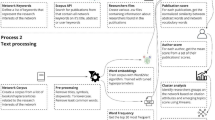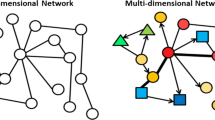Abstract
Information Communication Technology (ICT) has a significant impact on the socioeconomic development of a country. However, the inequitable access to ICT still remains a major issue in developing countries. In this context, this study examines ICT knowledge infrastructure in South Asia from a network point of view. Existing research on ICTs are useful in understanding the common facts, but are limited in revealing the hidden structures and properties of the ICT research domain in South Asia. The hidden structures and properties, like key players, network of key players for scientific collaborations, and their network characteristics are analyzed and synthesized in this study. This study applies the mixed approach of Social Network Analysis techniques and Triple Helix indicators on scholarly papers obtained from the Web of Science database. Further, burst detection algorithm is applied on keywords appearing in the titles of the South Asian ICT scholarly papers to understand the emerging trends in the ICT research domain. This study helps in providing a better understanding of current trends, strengths, and weaknesses of ICT in South Asia, which provides a better understanding to bridge the digital divide and achieve socioeconomic development through ICT.









Similar content being viewed by others
References
Bailey, A. (2009). Issues affecting the social sustainability of telecentres in developing contexts: A field study of sixteen telecentres in Jamaica. The Electronic Journal of Information Systems in Developing Countries, 26(4), 1–18.
Beaver, D. D. (2001). Reflections on scientific collaboration (and its study): past, present, and future. Scientometrics, 52(3), 365–377.
Berleur, J., & Chrisanthi, A. (2005). Perspectives and policies on ICT in society. New York: Springer.
Biggs, N., Lloyd, E., & Wilson, R. (1986). Graph theory. New York: Oxford Unviersity Press.
Chatziparadeisis, A. (2003). The R&D indicators in the knowledge-based economy: The research paradox. http://www.urenio.org/wp-content/The_Research_Paradox.pdf. Accessed 11 Dec 2012.
Chen, C. (2006). Citespace II: Detecting and visualizing emerging trends and transient patterns in scientific literature. Journal of American Society for Information science and Technology, 57(3), 359–377.
Chen, C., Chen, Y., Horowitz, M., Hou, H., Liu, Z., & Pellegrino, D. (2009). Towards an explanatory and computational theory of scientific discovery. Journal of Informetrics, 3(3), 191–209.
Davison, R., Vogel, D., Harris, R., & Jones, N. (2000). Technology leapfrogging in developing countries: An inevitable luxury? The Electronic Journal of Information Systems in Developing Countries, 1(5), 1–10.
Etzkowitz, H., & Leydesdorff, L. (2000). The dynamics of innovation: From national systems and mode 2 to a triple helix of university–industry–government relations. Research Policy, 29, 109–123.
Frame, J. D., & Carpenter, P. M. (1979). International research collaboration. Social Studies of Sciences, 9(4), 481–497.
Gonzalez, R., Gasco, J., & Llopis, J. (2006). Information system outsourcing: A literature analysis. Information and Management, 43, 821–834.
Guo, H., Weingart, S., & Borner, K. (2011). Mixed-indicators model for identifying emerging research areas. Scientometrics, 89, 421–435.
Gupta, B., Dasgupta, S., & Gupta, A. (2008). Adoption of ICT in a government organization in a developing country: An empirical study. Journal of Strategic Information Systems, 17, 140–154.
Khan, G. F. (2013). Social media-based systems: an emerging area of information systems research and practice. Scientometrics, 95, 159–180.
Khan, G. F., & Park, H. W. (2011). Measuring the triple helix on the web: Longitudinal trends in the university–industry–government relationship in Korea. Journal of American Society for Information science and Technology, 62(12), 2443–2455.
Khan, G. F., & Park, H. W. (2013). International collaboration within electronic government research domain: A triple helix network analysis of collaboration at the regional, country, and institutional levels. Government Information Quarterly, 30(2), 182–193.
Kleinberg, J. (2003). Bursty and hierarchical structure in streams. Data Mining and Knowledge Discovery, 7(4), 373–397.
Leydesdorff, L. (2001). Indicators of innovation in a knowledge-based economy. Cybermetrics, 5(1), 1–21.
Leydesdorff, L. (2003). The mutual information of university–industry–government relations: An indicator of the Triple Helix dynamics. Scientometrics, 58(2), 445–467.
Mane, K., & Borner, K. (2004). Mapping topics and topic bursts in PNAS. In Proceedings of the 2004 National Academy of Sciences of the United States of Americas (PNAS) (101(1), pp. 5287–5290).
Marsden, P. V. (2008). Network Data and Measurement (Vol. 1, Social Network Analysis). London: Sage.
Measuring the Information Society. (2012). International Telecommunication Union. http://www.itu.int/ITU-D/ict/publications/idi/. Accessed 13 July 2013.
Park, H. W., Hong, H. D., & Leydesdorff, L. (2005). A comparison of the knowledge-based innovation systems in the economies of South Korea and the Netherlands using Triple Helix indicators. Scientometrics, 65(1), 3–27.
Park, H. W., & Leydesdorff, L. (2010). Longitudinal trends in networks of university–industry–government relations in South Korea: The role of programmatic incentives. Research Policy, 39(5), 640–649.
Prasad, K. (2008). The digital divide: Implications of ICTs for development in South Asia. Papers in International and Global Communication, 3(08), 1–14.
Puri, S. K. (2007). Integrating scientific with indigenous knowledge: Constructing knowledge alliances for land management in India. MIS Quarterly, 31(2), 355–379.
Serrat, O. (2009). Social network analysis. Washington, DC: Asian Development Bank.
Shannon, C. E. (1948). A mathematical theory of communication. Bell System Technical Journal, 27, 379–423.
Shapiro, M. (2007). The triple helix paradigm in Korea: A test of new capital. International Journal of Technology Management and Sustainable Development, 6, 171–191.
Smith, M., Milic-Frayling, N., Shneiderman, B., Mendes Rodrigues, E., Leskovec, J., & Dunne, C. (2010). NodeXL: a free and open network overview, discovery and exploration add-in for Excel 2007/2010, http://nodexl.codeplex.com/ from the Social Media Research Foundation, http://www.smrfoundation.org. Accessed 13 July 2013.
Walsham, G., & Sahay, S. (2006). Research on information systems in developing countries: Current landscape and future prospects. Information Technology for Development, 12(1), 7–24.
Wasserman, S., & Faust, K. (1994). Social Network Analysis: Methods and applications. Cambridge: Cambridge university Press.
Author information
Authors and Affiliations
Corresponding author
Rights and permissions
About this article
Cite this article
Swar, B., Khan, G.F. Mapping ICT knowledge infrastructure in South Asia. Scientometrics 99, 117–137 (2014). https://doi.org/10.1007/s11192-013-1099-0
Received:
Published:
Issue Date:
DOI: https://doi.org/10.1007/s11192-013-1099-0




